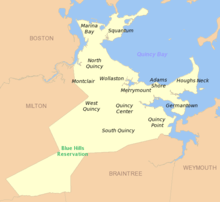Eastern Nazarene College
The Eastern Nazarene College (ENC) is a private, Christian college in Quincy, Massachusetts. Established as a holiness college in Saratoga Springs, New York, in 1900, the college had moved to Rhode Island for several years. With its expansion to a four-year curriculum, it relocated to Wollaston Park in 1919. It has expanded to additional sites in Quincy and, since the late 20th century, to satellite sites across the state. Its academic programs are primarily undergraduate, with some professional graduate education offered.
 Seal of the Eastern Nazarene College | |
Former names | Pentecostal Collegiate Institute (1900-1918)[1] |
|---|---|
| Motto | Via, Veritas, Vita |
Motto in English | The Way, the Truth, and the Life |
| Type | Private |
| Established | September 25, 1900 (PCI) June 14, 1918 (ENC) |
| Affiliation | Nazarene |
| Endowment | US $11,015,937 |
| President | Rev. Dr. Jack Connell |
| Students | 1,075 |
| Undergraduates | 927 |
| Postgraduates | 148 |
| Location | , , United States 42°16′15.5634″N 71°0′42.8076″W |
| Campus | Urban/Suburban 27 acres (109,265.1 m2) |
| Colors | Red & White |
| Nickname | Lions |
| Affiliations | AACU, CCCU, CIC, NAICU, NEASC |
| Website | www.enc.edu |
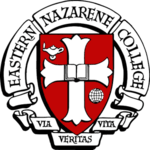 | |
History
New York
.jpg)
On September 25, 1900, several come-outer Methodist clergy and laymen affiliated with the 19th-century Holiness movement opened a co-educational collegiate institute at the Garden View House in Saratoga Springs, New York.[2] In a time when pentecostal served as a synonym for holiness,[3][4] it was named the Pentecostal Collegiate Institute (PCI). It was established to provide liberal education and ministry training in a preparatory academy, four-year college, and theological seminary.[5] PCI operated under the auspices of the Association of Pentecostal Churches of America (APCA), a loose association of Wesleyan-holiness churches[6] from eastern Canada down to the Middle Atlantic, and its own board of education.[7] Lyman C. Pettit served as its first president. PCI was accredited by the New York State Education Department's Board of Regents of the University of the State of New York[8] and was given state funding because a public school did not exist there at the time.[5] In 1901, the institute changed locations in Saratoga Springs, from the Garden View House to the former Kenmore Hotel.[9]
Rhode Island
The plans for a liberal arts college were delayed, however.[7][10] There was a falling out between Pettit and the APCA. The school was moved to Rhode Island, where it re-opened on September 16, 1902, in North Scituate, Rhode Island.[11] It did not yet have a post-secondary curriculum.[12] Having been the originator of the idea for establishing PCI and having already surveyed the Rhode Island location,[13] Fred A. Hillery had purchased the North Scituate campus on behalf of the association.[14] Its Greek Revival buildings were originally designed for the Smithville Seminary in 1839 by Russell Warren, the leading Greek Revival architect in New England in the 19th century.[15] The campus had been empty since 1876, when the Lapham Institute closed. After the move, the school attracted students from a variety of denominations. Only one-quarter to one-third of the student body was affiliated with the school's supporting denomination during any given academic year.[16] In 1907, the APCA merged with the Church of the Nazarene.[17] In 1908 PCI was one of the first three schools chosen to be officially affiliated with the Nazarenes.[18]
In 1917, it was decided to develop the planned liberal arts college.[19] On June 14, 1918, the Eastern Nazarene College was chartered with degree-granting authority in the state of Rhode Island.[20][21] Secondary education was conducted by the Eastern Nazarene Academy.[22] Choosing a new name, however, would be difficult: the school was now a liberal arts college and a Nazarene institution. Candidates included: "Northeastern Nazarene College", "Bresee Memorial College", "Nazarene College of the Northeast", and "Nazarene College and Bresee Theological Institute". General Superintendent John W. Goodwin is be credited with the chosen name. He wrote to Hiram F. Reynolds, a general superintendent and long-time supporter of the school: "I know you will do your best for our New England College. I should be glad if they would change the name to the Eastern Nazarene College, or something like that. It would seem we must have a school there, although it moves along hard and slow."[20]
Massachusetts
In 1919, the college moved to its current location in the Wollaston Park area of Quincy, Massachusetts. The founders wanted the new college to be located near either Harvard or Yale, so that its graduates could attend graduate school at one or the other. Quincy won out over New Haven, Connecticut because the educational standards were known to be higher in Massachusetts[23] In addition, president-elect Fred J. Shields would accept the position only if the college were to be located near Boston.[24] At the time of purchase, the 12-acre (49,000 m2) property was the site of the Josiah Quincy Mansion (1848), built for Josiah Quincy, Jr.[25] Angell Hall was built here. Other buildings included one from 1896, used for the classroom building called the Manchester, stables (1848) (Memorial Hall was built in 1948 on this site), and one from 1901, which now serves as Canterbury Hall.[26] The former PCI campus in Rhode Island was purchased in 1920 by William S. Holland, who moved his Watchman Institute there in 1923. He served African-American youths at that location for decades.
| J. E. L. Moore | 1918–1919 | |
| 1. | Frederick James Shields | 1919–1923 |
| 2. | Floyd William Nease | 1923–1930 |
| 3. | Robert Wayne Gardner | 1930–1936 |
| 4. | Gideon Brooks Williamson | 1936–1944 |
| 5. | Samuel Young | 1944–1948 |
| 6. | Edward Stebbins Mann | 1948–1970 |
| 7. | A. Leslie Parrott, Jr. | 1970–1975 |
| 8. | Donald Irwin | 1975–1980 |
| 9. | Stephen Wesley Nease | 1980–1989 |
| 10. | Cecil Roland Paul | 1989–1992 |
| 11. | Kent R. Hill | 1992–2001 |
| Albert L. Truesdale, Jr. | 2001–2002 | |
| 12. | J. David McClung | 2002–2005 |
| 13. | Corlis A. McGee | 2005-2017 |
The trustees of the college were incorporated by the state in 1920,[27] by which time its liberal arts identity had been "quite firmly established."[18] It did not gain Bachelor of Arts degree-granting power from the commonwealth for another decade, after the curriculum and faculty were established.[28] On January 28, 1930, President Floyd W. Nease appealed directly to the General Court of Massachusetts for degree-granting authority, defending ed his petition before the Joint Committee on Education and the state House and Senate. He cited financial records, campus improvement plans, and prominent community leaders; the bill passed in both houses and was signed by Governor Frank G. Allen on March 12, 1930.[29] The news reached the college the following afternoon.[30] The next year under President R. Wayne Gardner, the trustees reaffirmed that the college would remain "distinctly interdenominational and cosmopolitan in service."[31]
The college seal, designed by alumnus Harold G. Gardner and incorporating the college motto, Via, Veritas, Vita (Way, Truth and Life), was adopted by the trustees on the recommendation of the president and the student body in 1932.[32] A college banner displayed the emblems of Verbum, Lux, Spiritus, Crux.[24] The college had been chartered in 1918 with a school of music,[20][21] President Gardner secured certification for the college as a teacher-training institution with the Massachusetts Department of Education in 1933.[33] The college established a graduate program in theology starting in 1938.[34] It was one of two Nazarene schools before 1945 to offer graduate courses.[24] Evolutionary biology was taught in the classroom at least as early as 1937.[35] On May 8, 1941, Governor Leverett Saltonstall approved Eastern Nazarene to grant Bachelor of Science degrees.[34] By 1943 ENC had a cooperative degree program in engineering with Northeastern University.[36]
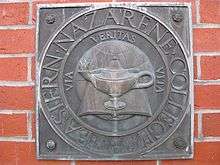
Under President Gideon B. Williamson on December 3, 1943, the Eastern Nazarene College gained accreditation from the New England Association of Colleges and Secondary Schools.[37] It was the second Nazarene college to gain institutional accreditation.[38] ENC was admitted to the Association of American Colleges in 1944,[37] and an affiliation with Quincy City Hospital for nurses' training began in that same year.[36] Eastern Nazarene was soon dubbed "Our Quincy's College" by the Quincy Patriot Ledger.[39] It works to maintain good town and gown relations with the city.[40]
The Eastern Nazarene Academy closed after 1955.[22] Starting in 1956, professors Timothy L. Smith and Charles W. Akers began to establish a community college for the city of Quincy.[41]
In 1964, the graduate course in theology was discontinued and replaced with a master's degree program in religion.[42] The college archives were created in 1963. The first history of the college, spanning from 1900 to 1950, was published by James R. Cameron in 1968.[43]
Under President Irwin in 1977, plans were made to relocate the college to a 125-acre (510,000 m2) parcel of land in Newtown Square, Pennsylvania, by purchasing the faltering Charles E. Ellis School for Girls.[44] The proposed move was unpopular among students and members of the Quincy community. Governor Michael Dukakis also urged the administration to reconsider. The college was outbid for the land by a corporation that wanted to establish an industrial park, and it stayed in Quincy.[45][46] In 1981, graduate degree offerings were expanded.[42] It started an accelerated program for working adults in 1990.[47] In 1991, a report issued by the Association of Independent Colleges and Universities in Massachusetts (AICUM) determined that the college contributed nearly $10 million to the local economy and brought in an estimated $7 million from outside the state.[48][49]
In 1992, President Kent Hill approved a policy to hire only Christian professors at the college. This decision generated controversy in the media but was intended for the hiring of new faculty. The American Civil Liberties Union (ACLU) determined that it was reasonable according to civil rights laws.[50] A second history of the college, spanning from 1950 to 2000, was started in 1993.[43]

In 1995, the college pursued relocation to a larger campus, planning to purchase the former 56-acre (230,000 m2) campus of the Boston School for the Deaf in Randolph, Massachusetts, from the Sisters of St. Joseph, but the deal fell through].[51] Instead, the college began to expand at other locations in Quincy, buying a piece of land along Hancock Street later that year,[52] and the year after that purchasing an adjoining parcel along Old Colony Avenue. This was the former site of a Howard Johnson's candy factory and executive offices.[53] In 1997, the college expanded beyond the metro Boston area for the first time, establishing a learning annex in central Massachusetts to serve as part of its adult studies division.[54]
The Old Colony Campus (OCC) in Wollaston, as the new site on Old Colony Avenue had come to be named, was renovated as the Adams Executive Center.[55] The Cecil R. Paul Center for Business was founded at the Old Colony location in 1999, and the James R. Cameron Center for History, Law, & Government was added in 2005.[56] In 2001, just before the end of his second term, then-president Kent R. Hill was appointed the new Global Health Administrator for USAID.[57] In 2008, ENC established satellite campuses in Boston, Brockton, Fall River, and Swansea, Massachusetts.[58][59]
College rankings
In 2010, Eastern Nazarene College was ranked in the top tier for northern U.S. regional colleges in U.S. News & World Report's Best Colleges report.[60] It was also ranked 28th overall (specifically 25th in number of graduates going on to earn PhDs and 11th in number of alumni serving in the Peace Corps, relative to college size) by the Washington Monthly College Guide for baccalaureate colleges nationally in 2010.[61]
Campus
Wollaston Park
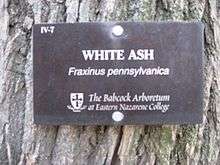
The 21-acre (85,000 m2) main campus[62] of the Eastern Nazarene College is situated in the Wollaston Park neighborhood of Quincy, Massachusetts. The Wollaston Park campus is 1.5 miles (2.4 km) southeast from the Boston city line and 6 miles (9.7 km) south of downtown Boston,[63] just over 1 mile (1.6 km) north of Quincy Center, 0.5 miles (0.80 km) northeast of the Wollaston T station,[64] and 0.25 miles (0.40 km) southwest from Wollaston Beach. ENC purchased the Wollaston Park property, as a 12-acre (49,000 m2) parcel, from the former Quincy Mansion School for Girls for $50,000 in 1919.[23] It has added to it over the years. The Mount Wollaston land belonging to the Quincy family had been broken up into prestigious building lots and named Wollaston Park in the late 19th century, to become one of Boston's first commuter neighborhoods,[65] The area remains primarily residential.
The campus has a registered arboretum, named the Babcock Arboretum after Vernor J. Babcock, and dedicated in 1993.[65] The alma mater, set to the tune of "Annie Lisle" with lyrics written by former president Edward S. Mann, refers to Quincy Bay and the elm trees for which Elm Avenue was named.[66] These died with the onset of Dutch elm disease in the early to mid-20th century.
The Anglican Parish of Saint George, established by the Anglican Mission in America, has been on campus since 2009.[67]
Historic buildings
The chandeliers of the Quincy Mansion (1848) were sold during the Great Depression in order to buy food for the students. The mansion was demolished in 1969 and Angell Hall was built on this site.[24]
The mansion was part of the Quincy family homestead, along with the Dorothy Quincy House and the Josiah Quincy House, on a 200-acre (0.81 km2) parcel of land known as the "Lower Farm". The mansion was the summer home of Josiah Quincy, Jr., then mayor of Boston. It was three stories and white, in Georgian architecture, with marble fireplaces in most of the rooms and large French windows on the first floor that "opened upon either little balconies or broad piazzas."[26] Elm Avenue had been the avenue, or driveway, for the two mansions on the property.[65] The first of the two, the Josiah Quincy House (1770), still stands on Muirhead Street.
Both Gardner Hall (1930), originally named the Fowler Memorial Administration Building after Charles J. Fowler, and the original Floyd W. Nease Library (1953), now the Bower-Grimshaw Center for Institutional Advancement, were designed by Wesley Angell. Gardner Hall was designed in the Classical or Colonial Revival mode. Gardner is brick, three stories on a high granite basement, and capped by a parapet balustraded in the center. Corners are articulated with brick quoins. The fenestration is symmetric with double sash windows at regular intervals, trimmed in white, topped with flared brick lintels and a white keystone. It also features a two-story balustraded Doric portico of fluted cast stone columns. The portico is the backdrop for commencement ceremonies. The main entrance, at the end of wide stairs, is pilastered and topped with a bracketed entablature, which frames an arched glass opening. The side elevations have projecting stair towers, which indicate the site of a central hall running the length of the building. Originally rectangular in form, the 1953 addition of the then-Nease Library in the rear gave it a T-configuration.[68]
.jpg)
Memorial Hall (1948) is the only building on campus, other than the pre-existing Canterbury Hall (1901), not to be named for an individual. Rather, it was built as a memorial to those who had served in the Second World War. Over two hundred alumni had served, and six students had lost their lives in the war.[69]
Old Colony and other locations
The 6-acre (24,000 m2) Old Colony Campus (OCC), named for its location on Old Colony Avenue in Quincy, has two buildings. The "180 building" is the Adams Executive Center, which houses the business department in the Cecil R. Paul Center for Business, established in 1999.[56] The building at 162 Old Colony houses the college archives and offices for the history department, as part of the James R. Cameron Center for History, Law, and Government, established in 2005. It also has separate offices for mathematics, and physics and engineering departments. In addition, the Campus Kinder Haus (CKH), an early childhood education center, is located here.[70] CKH was founded in 1979 and moved to the Old Colony Campus in 2000.[71] The college also owns adjacent undeveloped land between Old Colony and Hancock streets in Quincy, at the Southern Artery.[72] This has been rezoned by the city several times.[73] Quincy officials announced in 2009 that they might take the land by eminent domain for construction of a new middle school.[74]
In addition to its campuses in Quincy, the college established a learning annex called the Auburn Learning Center in Auburn, Massachusetts, in 1997 to serve as part of the Leadership Education for Adults Division.[54] In 2008 it added satellite campuses in Boston, Brockton, Fall River, and Swansea.[58][59]
Organization
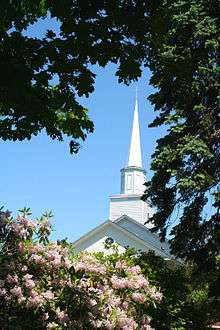
Religious affiliation
Higher education is, historically, one of the Nazarenes' most important emphases. The Nazarenes provide their colleges with "students, administrative and faculty leadership, and financial and spiritual support.... the college, while not a local congregation, is an integral part of the church; it is an expression of the church."[75] Founded under the auspices of the Association of Pentecostal Churches of America, ENC was one of the first three schools officially chosen to be Nazarene institution in 1915,[18] making it the oldest continuously operating educational institution affiliated with the Nazarenes. As one of eight Nazarene liberal arts colleges[76] in the United States,[77] the college receives financial backing equivalent to a $40 million endowment from its constituent churches.[78] Eastern Nazarene is also bound by a gentlemen's agreement not to actively recruit outside its respective educational region,[79] which extends southwest from Maine as far as Pennsylvania and Virginia in the United States[80][81] and provides trustees for the college.[82] The institution is otherwise largely independent, having been multi-denominational since 1902,[16] and tuition-driven, with an actual endowment of only US $11,015,937.[83] The president and trustees of the college determined in 1931, one year after gaining its charter to grant degrees in Massachusetts, that it is part of the college's mission to be "distinctly interdenominational and cosmopolitan in service."[31] Students are not required to profess any religion, although chapel attendance is required and faculty members are required to be Christians.[84]
Academic associations
The now-defunct secondary school, the Pentecostal Collegiate Institute, was accredited by the New York State Education Department's Board of Regents upon its founding in 1900.[8] When it was first chartered in 1918, the Eastern Nazarene College was granted the authority to grant baccalaureate degrees in Rhode Island,[21] and was later chartered with that same authority in Massachusetts in 1930.[30] Teacher education was recognized by the Department of Education of the Commonwealth of Massachusetts in 1933[33] and is also approved by the National Association of State Directors of Teacher Education and Certification and the Massachusetts Board of Higher Education, as well as benefitting from the Interstate Certification Compact for all teacher education programs, which allows graduates to teach in 44 states and the District of Columbia.[85][86] ENC gained institutional accreditation from the Commission on Institutions of Higher Education of the New England Association of Schools and Colleges (NEASC)[87] in 1943,[88] and the social work program has been accredited by the Council on Social Work Education since 1979.[89] Eastern Nazarene joined the Association of American Colleges in 1944,[37] has been a member of the Council for Christian Colleges and Universities (CCCU) since 1982,[90] and is also a member of both the Council of Independent Colleges (CIC)[91] and the National Association of Independent Colleges and Universities (NAICU).[92]
Academics
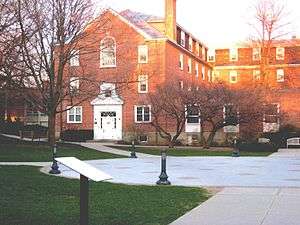
According to some of the college's earliest and most influential figures, the Eastern Nazarene College has always existed with the idea in mind that one can be a Christian and an intellectual scholar: Bertha Munro, the first dean of the college is often quoted as having said that "there is no conflict between the best in education and the best in Christian faith"[93] and former history professor Timothy L. Smith, who began his career at ENC, is widely considered the first evangelical Christian to gain academic prominence,[94] while ENC alumnus and physicist Karl Giberson has worked to address the Creation-Evolution controversy and was Executive Vice President of the BioLogos Foundation until May 2011.[95] Though it makes no religious requirements of its students, Eastern Nazarene has required that its faculty members be Christian since 1993.[84] The school currently has three college divisions: the Traditional Undergraduate Division, the Adult Studies Division (often called the Leadership Education for Adults Division, or LEAD), and the Graduate Division.[91] There were 1,075 students enrolled at the college in 2007, 927 of whom were undergraduate and 148 of whom were graduate students.[96] Admission is selective[97] on a rolling deadline and the 2007 acceptance rate for students who applied to the college was 61.7 percent.[83]
Traditional Undergraduate division
Most degree offerings at Eastern Nazarene are baccalaureate degrees. In the Traditional Undergraduate Division, the college offers associate's and bachelor's (Bachelor of Arts and Bachelor of Science) liberal arts degrees in 50 majors, with 57 minors and six pre-professional programs for a combined total of 80 programs of study, including dual degree programs with Northeastern University and the Massachusetts College of Pharmacy and Health Sciences leading to the doctor of pharmacy.[91] In addition to co-operative programs and internship opportunities around Boston, Eastern Nazarene provides a number of intercollegiate and off-campus programs at 56 Nazarene institutions of higher education around the world. Students may also participate in the "Best Semester"[98] study abroad program, and ENC offers an additional semester-long program in Romania.[42] The college uses a "4-1-4 system"[83] for its academic year: there are two full semesters in the Fall and Spring, each roughly four months long, and a one-month term in May known as "May Term".
Eastern Nazarene emphasizes a blend of faith and other pursuits, from biology[99] to business,[100] and has won the John Templeton award for science-and-religion education.[101] The undergraduate curriculum at Eastern Nazarene was developed in 1919 by the first dean of the college, Bertha Munro, and originally modeled after the curricula at Radcliffe College and Boston University.[24] A revision that introduced the Cultural Perspectives core sequence is very distinctive and comprises a series of interdisciplinary courses on Western culture that encourages students to ponder the "tensions and possibilities" in the relationships between the Christian faith and societal values.[42] The traditional undergraduate student-to-faculty ratio at Eastern Nazarene is 11:1,[83] and graduates on average have a 94 percent acceptance rate into medical school as well as a 100 percent acceptance rate into law school.[102]
Graduate Division and LEAD
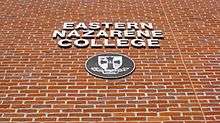
In addition to traditional undergraduate education, the college offers continuing education for working adults through the Leadership Education for Adults Division (LEAD). Accelerated programs have been in place since 1990,[47] and now include bachelor's degree completion (Bachelor of Arts and Bachelor of Science degrees) and associate's degrees (the associate of arts degree) as well as certificates in paralegal studies (CPS) and human resource management (CHRM).[103] The college also maintains 2+2 programs[104] and articulation agreements with junior colleges in the surrounding geographical area, like the agreements with Bristol, Massasoit, and Roxbury Community Colleges.[58][59] Most LEAD classes are held at the Old Colony Campus or at one of the four satellite campuses for reasons of transportation and accessibility.
Graduate offerings from the Graduate Division are primarily master's degrees (master of science and master of education).[103] Eastern Nazarene first offered graduate work in theology in 1938,[34] then replaced it with a master's degree in religion in 1964, and added master's degrees in business, education, and psychology in 1981.[42]
Student life

ENC is 24 percent ethnically diverse,[105] the highest diversity rate among the eight Nazarene liberal arts colleges,[106] and black student enrollment rose from 4.9 to 15 percent between 1997 and 2007.[107] Eastern Nazarene has always been co-educational, and most of the traditional undergraduate population lives on campus.[108] Undergraduate students at ENC are typically affiliated with approximately 30 different Christian denominations (the largest representations being Nazarene, Baptist, Catholic, and non-denominational), while 35 percent of the student population had no reported denominational or religious affiliation.[84]
No student is required to be Christian to attend the Eastern Nazarene College,[84] but each traditional undergraduate student, upon registering, agrees to what is called a Lifestyle Covenant: to, among other things, "abstain from the use of illegal drugs, alcohol and tobacco, and to avoid attendance at bars, clubs, or other activities or places of entertainment that promote themes of inappropriate sexuality, violence, profanity, pornography or activities demeaning to human life."[109] The Student Handbook also specifies that "No person shall engage in sexual acts with anyone other than a spouse."[110] While some guidelines might appear to be "relics from another era," according to the Boston Globe,[111] the Globe has also noted that other prominent Christian colleges uphold these ideals,[112] and that Eastern Nazarene is known for being a progressive "trendsetter"[106] with a "slightly more liberal bent" than its peers.[111] The John Templeton Foundation has also cited Eastern Nazarene College as an institution that builds character,[113] and the Quincy Patriot Ledger has said that the school's "deep religious roots make for a quiet campus and good neighbors."[40]
Extracurriculars
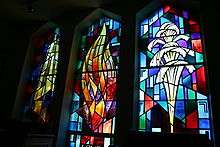
There are no fraternities or sororities on campus, but there are Greek "societies". Until 2002, there were four societies based on intramural sports competition, which included the "Kappa Cougars", the "Sigma Stallions", and the "Zeta Warriors". New societies were formed in 2007 and originally numbered eight but were reduced to four again in 2008. These societies are not currently active.
There has been an Honors Scholar Society since 1936,[114] and there are various national honors societies (Phi Alpha Theta for history majors, Phi Delta Lambda for Nazarene scholars,[115] Psi Chi for psychology majors, etc.). Students participate in the Student Government Association (SGA), Class Council, Students for Social Justice,[116] academic clubs (Beta Phi Mu Shrader Club, Biology Club, History Club, etc.), and club sports. The student-run newspaper is "The Veritas News" (formerly the Campus Camera), since 1933 and regularly published since 1936, and the student-developed yearbook has been the Nautilus since 1922.[117]
There are vocal and instrumental ensembles, including the A Cappella Choir,[118] which was formed in 1938,[114] and Chamber Singers, Gospel Choir, Symphonic Winds, and Jazz Band, among several others. The college also has a student theatre organization.[119][120] There exist both campus-oriented and community-oriented ministries like as "Open Hand, Open Heart", which ministers to the homeless of Boston by providing food, clothing, and blankets.[121] In addition to its study abroad programs, ENC also provides missions opportunities through a program known as "Fusion".[122] Locally, environmental management students have been involved in community cleanup programs[116][123] and archaeological investigations around Quincy.[124]
Athletics
Intramural sports take place year-round and change from season to season based on student interest (past sports have included lacrosse, field hockey, and a very successful men's volleyball club).[125] These and other campus sports, such as J-Term basketball, men's wrestling, men's football, powder puff football, and indoor soccer, are organized by the Student Government Association's (SGA) Rec. Life director.[126]
Intercollegiate athletics at ENC first began in 1959 with wins over Gordon, Curry, and Barrington Colleges in baseball.[127] Varsity sports are National Collegiate Athletic Association (NCAA) Division III, Commonwealth Coast Conference (CCC),[128] and New England Collegiate Conference (NECC). Along with NNU, ENC is one of only two Nazarene colleges to compete in the NCAA. Men's varsity sports include baseball, basketball, cross-country, golf, soccer, tennis, track and field, and volleyball. Women's sports include basketball, cross-country, soccer, softball, tennis, track and field, and volleyball. When NAIA-affiliated,[129] Eastern Nazarene regularly won the basketball tournament hosted by The King's College.[130] The college also won the ECAC Division III Championship in 1996[131] and went to the NCAA Division III Sweet 16 in 2000.[132][133]
Eastern Nazarene's athletic nickname is "Lions".[134] From 1959 until 2009, the athletic moniker was "Crusaders".[127] The college colors are red and white.[135] Bradley Field is named in honor of Carroll Bradley, one-time professional baseball player and the first athletic director at Eastern Nazarene,[127] and the LaHue Physical Education Center at ENC also serves as a clinical site for Northeastern University.[136]

Residential life
Students live in single-sex residence halls. There are three female dormitories (Spangenberg Hall, Williamson Hall, and Munro Hall) and two male dormitories (Memorial Hall and Shields Hall). Young Hall provides apartments for staff and married students, in addition to suites for upperclassman females and males. Each dormitory houses a co-ed common area, known as a parlor.
The Mann Student Center houses The Commons for sit-down meals cafeteria-style, as well as The Dugout for meals in a café-type atmosphere. The latter is a popular location for social gathering, as is the adjacent "Colonel's Coffee House". Chapel services for undergraduate students, which are 40 minutes long,[137] are offered on Wednesdays and Fridays.[138] Attendance for most chapels is required for most undergraduates.[139]
Notable persons
Notable alumni
Samuel Young, Edward S. Mann, and Stephen W. Nease were all ENC alumni and presidents of Eastern Nazarene College. Russell V. DeLong served two non-consecutive terms as president of Northwest Nazarene College, and also served as president of Pasadena College. John E. Riley, Kenneth H. Pearsall, and A. Gordon Wetmore also served as presidents of NNC. Stephen Nease and Gordon Wetmore later served as presidents of the Nazarene Theological Seminary. Stephen Nease was also the president of Bethany Nazarene College in Bethany, Oklahoma, and the founding president of Mount Vernon Nazarene College. William Henry Houghton was the fourth president of the Moody Bible Institute in Chicago], and Charles W. Akers was the first president of Quincy Junior College (QJC). Alumnus Donald Young, Samuel Young's son,[140] would also become a president of Quincy College.[141][142]
Lawrence Yerdon is the president of the Strawbery Banke Museum. He also served 1986-2004 as president of the Hancock Shaker Village, and was director of the Quincy Historical Society 1976-1986.[143] Alumnus Edward Thomas Dell, Jr. was a published author, the editor of The Episcopalian from 1968 to 1973, and founder of two magazines, and he kept a running correspondence with C. S. Lewis, which is now archived in the Bodleian Library and at Wheaton College.[144] Ralph Earle, Jr. served on the Committee on Bible Translation for the New International Version of the Bible.
John S. Rigden is an alumnus and physicist. Eldon C. Hall was the lead design engineer of the Apollo Guidance Computer (AGC) at MIT. Carl Crouthamel earned his doctorate at the University of Chicago after graduating from ENC, is known for his work with Enrico Fermi on the U.S. project that produced the first atomic bomb, started the first program to build a gamma ray lens for use in astronomy, and has worked for the Argonne National Laboratory.[145]
Floyd Nease, Stephen's son and Floyd's grandson, is the Democratic Party Majority Leader for the Vermont House of Representatives. James Sheets, former six-term Quincy mayor, is an Eastern Nazarene College graduate.[146] David Bergers serves as the current Director for the Boston Regional Office of the Securities and Exchange Commission, and attended Yale Law School after completing his undergraduate education at ENC.[147][148]
Richard R. Schubert, another ENC alumnus and graduate of Yale Law School, was the founding president of the Points of Light Foundation, former president and vice chairman of the Bethlehem Steel Corporation, general counsel and deputy secretary for the U.S. Department of Labor, and president and chief executive officer (CEO) of the American Red Cross.[149][150] Neil Nicoll is the current President & CEO of the YMCA.[151][152] Jim Tabor is Vice President for Operations at AirTran Airways.[153] Harry Palmer was president of Atco Records,[154] a division of Atlantic Records that produced albums by The Rolling Stones, Aretha Franklin and AC/DC. Samuel Jean,[155] graduated from Eastern Nazarene in 1992 with a bachelor's degree in history[156] before graduating from Boston University School of Law in 1995 and is the founder of CityView Artist Management.[157]
Esther R. Sanger, noted social worker, preacher, and founder of the Quincy Crisis Center and the Mary-Martha Learning Center, attended the Eastern Nazarene preparatory academy and earned a B.A. in social work and an M.A. in family counseling at ENC.[158]
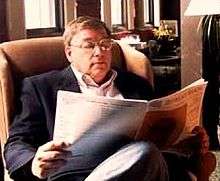
Notable faculty
Chemistry professor Lowell Hall is the creator of "Molconn", which Pfizer uses to test drug potency,[159] and is emeritus program chairman of the Boston Area Group for Informatics and Modeling.[160] History professor Randall J. Stephens is editor of both the Journal of Southern Religion and Historically Speaking, which is produced at Boston University and published by the Johns Hopkins University. Donald A. Yerxa is director of The Historical Society (THS) at Boston University. He and fellow history professor James R. Cameron both studied under Charles W. Akers and Timothy L. Smith.
Former faculty members of note include physicist John S. Rigden, historian and community college president Charles W. Akers, biblical scholar Ralph Earle, Jr., historian Timothy L. Smith, theologian Thomas Jay Oord, inspector general and Massachusetts representative Robert A. Cerasoli, historian and seminary president Hugh C. Benner, and Olive Winchester. Presidents of the college who were first faculty members include Fred J. Shields in psychology, Floyd W. Nease in theology, R. Wayne Gardner in mathematics, Samuel Young in theology, Edward S. Mann in mathematics, and Cecil R. Paul in psychology.
Notes and references
- American universities and colleges: a dictionary of name changes by Alice H. Songe. Rowman & Littlefield (1978), p. 62
- Cameron, James R. (1968). Eastern Nazarene College—The First Fifty Years, 1900-1950. Kansas City: Nazarene Publishing House. p. 17.
- "Birth of a Church" (PDF). Church of the Nazarene. Archived from the original (PDF) on May 9, 2010. Retrieved July 24, 2009.
- "History of the Church of the Nazarene". Archived from the original on 2008-01-13. Retrieved 2008-07-10.
- Cameron, James R. (1968). Eastern Nazarene College—The First Fifty Years, 1900-1950. Kansas City: Nazarene Publishing House. pp. 20–21.
- Cameron, James R. (1968). Eastern Nazarene College—The First Fifty Years, 1900-1950. Kansas City: Nazarene Publishing House. p. 27.
- Ingersol, Stan. "Why These Schools? Historical Perspectives on Nazarene Higher Education" (PDF). Archived from the original (PDF) on 2008-06-24. Retrieved 2008-07-10. Cite journal requires
|journal=(help) - Smith, Timothy L. (1962). Called Unto Holiness (PDF). Kansas City: Nazarene Publishing House.
- "Saratoga Hotel Sold" (PDF). The New York Times. September 17, 1901. Retrieved 2008-07-10.
- Cameron, James R. (1968). Eastern Nazarene College—The First Fifty Years, 1900-1950. Kansas City: Nazarene Publishing House. pp. 28–29, 33.
- Scituate, Rhode Island. Arcadia Publishing. 1998. p. 127. ISBN 0-7385-6419-2.
- Cameron, James R. (1968). Eastern Nazarene College—The First Fifty Years, 1900-1950. Kansas City: Nazarene Publishing House. pp. 33–36.
- Cameron, James R. (1968). Eastern Nazarene College—The First Fifty Years, 1900-1950. Kansas City: Nazarene Publishing House. pp. 32–33.
- Cameron, James R. (1968). Eastern Nazarene College—The First Fifty Years, 1900-1950. Kansas City: Nazarene Publishing House. p. 34. Originally "built and equipped for $78,000," Hillery bought it for $4,500 and negotiated a mortgage for $3,000.
- Beth L. Savage and Carol D. Shull (1995). African American Historic Places. John Wiley and Sons. p. 422. ISBN 978-0-471-14345-1.CS1 maint: uses authors parameter (link)
- Cameron, James R. (1968). Eastern Nazarene College—The First Fifty Years, 1900-1950. Kansas City: Nazarene Publishing House. pp. 46, 53, 61, 175.
- Cameron, James R. (1968). Eastern Nazarene College—The First Fifty Years, 1900-1950. Kansas City: Nazarene Publishing House. p. 52.
- Raser, Harold E. (1996). Thomas C. Hunt; James C. Carper (eds.). Religious Higher Education in the United States. Taylor & Francis. p. 547. ISBN 0-8153-1636-4.
- Cameron, James R. (1968). Eastern Nazarene College—The First Fifty Years, 1900-1950. Kansas City: Nazarene Publishing House. pp. 125–126.
- Cameron, James R. (1968). Eastern Nazarene College—The First Fifty Years, 1900-1950. Kansas City: Nazarene Publishing House. p. 130.
- Cameron, James R. (1968). Eastern Nazarene College—The First Fifty Years, 1900-1950. Kansas City: Nazarene Publishing House. p. 137.
- Cameron, James R. (2000). The Spirit Makes the Difference: The History of Eastern Nazarene College, Part II, 1950-2000. Quincy, Massachusetts: ENC Press. p. 57.
- Cameron, James R. (1968). Eastern Nazarene College—The First Fifty Years, 1900-1950. Kansas City: Nazarene Publishing House. pp. 146–147.
- Munro, Bertha (1970). The Years Teach, an Autobiography: Remembrances to Bless (PDF). Kansas City: Beacon Hill Press.
- Pepe, William J.; Elaine A. Pepe (2008). Postcard History Series: Quincy. Arcadia Publishing. p. 72. ISBN 978-0-7385-5539-3.
- Cameron, James R. (1968). Eastern Nazarene College—The First Fifty Years, 1900-1950. Kansas City: Nazarene Publishing House. p. 147.
- Hood, William Ross (1922). State Laws Relating to Education Enacted in 1920 and 1921. District of Columbia: Department of the Interior: Bureau of Education. p. 224.
- Cameron, James R. (1968). Eastern Nazarene College—The First Fifty Years, 1900-1950. Kansas City: Nazarene Publishing House. p. 163. Before 1930, an arrangement was made with Northwest Nazarene College for students to receive degrees from that institution instead.
- Cameron, James R. (1968). Eastern Nazarene College—The First Fifty Years, 1900-1950. Kansas City: Nazarene Publishing House. pp. 194–195.
- "Gov. Allen Signs Nazarene College Degree Grant Bill". The Patriot Ledger. March 14, 1930.
- Cameron, James R. (1968). Eastern Nazarene College—The First Fifty Years, 1900-1950. Kansas City: Nazarene Publishing House. p. 263.
- It is derived from Jesus' words, "I am the way and the truth and the life...." from John 14:6. Professor Jesse B. Mowry said, "Yea, the Truth points the Way and the Life, and these three determine man's destiny!" Cameron, James R. (1968). Eastern Nazarene College—The First Fifty Years, 1900-1950. Kansas City: Nazarene Publishing House. pp. 38, 220.
- Cameron, James R. (1968). Eastern Nazarene College—The First Fifty Years, 1900-1950. Kansas City: Nazarene Publishing House. pp. 248, 401.
- Cameron, James R. (1968). Eastern Nazarene College—The First Fifty Years, 1900-1950. Kansas City: Nazarene Publishing House. p. 333.
- Cameron, James R. (1968). Eastern Nazarene College—The First Fifty Years, 1900-1950. Kansas City: Nazarene Publishing House. p. 318.
- Cameron, James R. (1968). Eastern Nazarene College—The First Fifty Years, 1900-1950. Kansas City: Nazarene Publishing House. p. 330.
- Cameron, James R. (1968). Eastern Nazarene College—The First Fifty Years, 1900-1950. Kansas City: Nazarene Publishing House. p. 293.
- Purkiser, Westlake Taylor (1983). Called Unto Holiness, Vol. 2 (PDF). Kansas City: Nazarene Publishing House. The first was the Northwest Nazarene College in Idaho.
- "Our Quincy's College". The Patriot Ledger. October 5, 1948. pp. 1, 4.
- "Editorial: Quincy home to more collegians". Patriot Ledger. August 23, 1996.
- "History Department". Eastern Nazarene College. Archived from the original on February 2, 2009. Retrieved August 4, 2009.
- Balmer, Randall Herbert (2004). Encyclopedia of Evangelicalism. Baylor University Press. p. 224. ISBN 978-1-932792-04-1.
- Davis, Joy (December 5, 2000). "Second volume added to Eastern Nazarene history". The Patriot Ledger.
- "Eastern Nazarene College Leaving Massachusetts for Pennsylvania". The New York Times. March 20, 1977. p. 5.
- Cameron, James R. (2000). The Spirit Makes the Difference: The History of Eastern Nazarene College, Part II, 1950-2000. Quincy, Massachusetts: ENC Press. p. 283.
- Ferguson, Gailynne M. (March 30, 1999). "History of the Ellis School". EllisAlum.org. Archived from the original on December 3, 2009. Retrieved July 24, 2009.
- Salter, Sue (Summer 1997). "From the Chair" (PDF). News Vol. 7 No. 2. Consortium for the Advancement of Adult Higher Education. Archived from the original (PDF) on 2011-07-25. Retrieved 2009-05-29.
- "Association of Independent Colleges and Universities in Massachusetts (AICUM)". Retrieved 2009-05-29.
- "ENC Boosts Local Economy By Nearly $10 Million". The Quincy Sun. October 31, 1991. p. 33.
- Coakley, Tom (April 27, 1993). "Faculty shift ahead at Christian college". Boston Globe.
- Markoe, Lauren (January 4, 1995). "College bids for Randolph campus". The Patriot Ledger.
- April, Carolyn (July 27, 1995). "Eastern Nazarene buying motel site". The Patriot Ledger.
- Davis, Maia (August 20, 1996). "Expansion plans move ahead: ENC to buy former Quincy factory". The Patriot Ledger.
- Salter, Sue (Summer 1997). "New Learning Center Launched at ENC" (PDF). News Vol. 7 No. 2. Consortium for the Advancement of Adult Higher Education. Archived from the original (PDF) on 2011-07-25. Retrieved 2009-05-29.
- Givens, Ann (October 1, 1998). "Eastern Nazarene College is expanding 2 Wollaston buildings undergoing renovation". The Patriot Ledger.
- "Photo tour: Cecil R. Paul Center for Business". Retrieved 2009-03-07.
- Davis, Joy (August 7, 2001). "Christians-only policy not for U.S. agency; Ex-ENC president will eschew practice at Quincy college". The Patriot Ledger. p. 7.
- "ENC's Adult and Graduate Studies Program expands into satellite locations around the state". Nazarene Communications Network. December 18, 2008. Archived from the original on December 23, 2008.
- Hatch, Steve (January 25, 2009). "Brockton: Extending Education". Boston Globe. Boston.com. Retrieved July 23, 2009.
- USNews and World Report Guide to Best Colleges: Eastern Nazarene College
- Washington Monthly College Guide: Baccalaureate college rankings 2010 Archived 2011-05-14 at the Wayback Machine
- Campus map (Map). Retrieved 2008-07-10.
- "Eastern Nazarene College: About". Archived from the original on 2008-12-21. Retrieved 2009-05-19.
- "Wollaston MBTA Station (with Google map)". Retrieved 2008-07-10.
- Information provided by the Eastern Nazarene College, History of the Babcock Arboretum, published in 2003, written by Gerry Wood, founder. Found in the Nease Library, Reference Section.
- "Alumni Relations at Eastern Nazarene College". Archived from the original on 2009-01-12. Retrieved 2008-12-30.
- "New Anglican Church". The Patriot Ledger. February 28, 2009.
- "Historical and architectural significance of the campus of Eastern Nazarene College". Retrieved 2008-07-10.
- Cameron, James R. (2000). The Spirit Makes the Difference: The History of Eastern Nazarene College, Part II, 1950-2000. Quincy, Massachusetts: ENC Press. p. 11.
- "Photo tour: Campus Kinder Haus". Retrieved 2009-01-03.
- Davis, Joy (September 26, 2000). "Kinder Haus finally at home". The Patriot Ledger.
- "Rezoning of parcel debated; Property value would drop, says Eastern Nazarene". Patriot Ledger. September 24, 2002.
- "City council rezones college land; Officials at ENC opposed the move". Patriot Ledger. October 9, 2002.
- Encarnacao, Jack (July 9, 2009). "Quincy looking to take inn, other properties to create site for new middle school". Patriot Ledger. PatriotLedger.com. Archived from the original on August 5, 2009. Retrieved July 23, 2009.
- Manual of the History, Doctrine, Government, and Ritual of the Church of the Nazarene (PDF). Kansas City: Nazarene Publishing House. 2005. p. 170. Archived from the original (PDF) on 2013-03-02.
- J. Matthew, Price. "Liberal Arts and the Priorities of Nazarene Higher Education" (PDF). Archived from the original (PDF) on 2008-06-27. Retrieved 2008-07-10. Cite journal requires
|journal=(help) Nazarene higher education is based on the liberal arts college model. While ENC is the only Nazarene institution to retain the "college" moniker, no Nazarene schools fit the standard national definition of a "research university". Furthermore, the Massachusetts Board of Higher Education holds a "two doctorate" standard. - "US Educational Regions" (PDF). Archived from the original (PDF) on 2011-09-29. Retrieved 2008-07-10. ENC and NNU are the only Nazarene schools to remain true to their regional names.
- Jaschik, Scott; Kate Maternowski (May 11, 2009). "Show me the money". Inside Higher Ed. Retrieved 2009-05-13.
- Guidelines and Handbook for Educational Institutions of the Church of the Nazarene (PDF). Church of the Nazarene International Board of Education. 1997. p. 14. Archived from the original (PDF) on 2009-10-10. Retrieved 2009-05-24.
- "Eastern USA Region" (PDF). Archived from the original (PDF) on 2009-02-06. Retrieved 2008-07-10.
- When first established on June 10, 1918, this region also included Ohio, West Virginia, maritime Canada, and the British Isles. Manual of the History, Doctrine, Government, and Ritual of the Church of the Nazarene (PDF). Kansas City: Nazarene Publishing House. 1919.
- Cameron, James R. (1968). Eastern Nazarene College—The First Fifty Years, 1900-1950. Kansas City: Nazarene Publishing House. p. 131.
- "Eastern Nazarene College". Guide to Best Colleges. U.S. News and World Report. Retrieved 2009-05-19.
- Davis, Joy (March 25, 2000). "Faith in God a must for faculty of religious colleges". The Patriot Ledger. p. 24.
- "UMass Teacher Education RE: Interstate Certification Compact". Archived from the original on 2008-06-19. Retrieved 2008-07-10.
- "Eastern Nazarene College Catalogue 2007-2008, p. 9" (PDF). Archived from the original (PDF) on 2008-06-27. Retrieved 2008-07-10.
- "NEASC Accreditation Roster". Archived from the original on 2008-03-15. Retrieved 2008-07-10.
- "Details from NEASC". Retrieved 2008-07-10.
- "CSWE 2006 Directory of Accredited Programs". Retrieved 2008-07-10.
- CCCU member details: Eastern Nazarene College Archived 2008-10-24 at Archive.today
- "Eastern Nazarene College 2008-2009 Undergraduate Catalog" (PDF). Archived from the original (PDF) on 2008-12-02. Retrieved 2008-03-08.
- "NAICU Members — E". Archived from the original on 2015-11-09. Retrieved 2008-07-10.
- Cameron, James R. (1968). Eastern Nazarene College—The First Fifty Years, 1900-1950. Kansas City: Nazarene Publishing House. p. 317.
- "Historian Smith, 72, Dies". Obituaries. Christianity Today. 7 April 1997. Retrieved 2009-05-19.
- "Karl Giberson Moves On to Create More Time for Writing". The BioLogos Forum. BioLogos.org. Archived from the original on 2015-09-21. Retrieved 2011-10-25.
- "Search for Schools, Colleges, and Libraries". U.S. Department of Education National Center for Education Statistics. Retrieved 2009-04-14.
- "Eastern Nazarene College". Carnegie Classification. Carnegie Foundation for the Advancement of Teaching. Retrieved 2009-05-19.
- "Best Semester". Retrieved 2008-07-10.
- Lambert, Lane (March 5, 2008). "Making room for God and evolution; Nazarene prof says they're not mutually exclusive". The Patriot Ledger. p. 1.
- Lambert, Lane (November 15, 2006). "Speaker preaches faith in the office; Former investment banker says companies should embrace the Lord's work". The Patriot Ledger. p. 10.
- "Professors honored for science-religion course Eastern Nazarene program explores common ground". Patriot Ledger. August 24, 1996.
- "Eastern Nazarene College History". Retrieved 2008-07-10.
- "Adult and Graduate Programs". Archived from the original on 2007-07-14. Retrieved 2008-07-10.
- "2+2 BAM Programs". Retrieved 2008-07-10.
- "ENC Named One of "America's Best Colleges"" (Press release). Eastern Nazarene College. February 5, 2007. Archived from the original on June 5, 2009. Retrieved February 8, 2009.
- Johnson, Carolyn Y. (July 31, 2005). "A calling to educate: New head of Christian college aims to train 'people of value'". Boston Globe. Boston.com. Retrieved July 23, 2009.
- Redden, Elizabeth (August 15, 2008). "Christian Colleges Grow More Diverse". InsideHigherEd.com.
- "ENC Student Handbook (p. 27)" (PDF). Archived from the original (PDF) on 2009-02-06. Retrieved 2009-06-11.
- "Eastern Nazarene College Application for Undergraduate Admission". Archived from the original on 2008-09-07. Retrieved 2008-07-10.
- "ENC Student Handbook (11.2, p. 51)" (PDF). Archived from the original (PDF) on 2009-02-06. Retrieved 2009-06-11.
- Johnson, Carolyn Y. (July 31, 2005). "School's religious focus remains as rules evolve". Boston Globe. Boston.com. Retrieved July 23, 2009.
- MacQuarrie, Brian (November 14, 2005). "On Christian campus, an all-embracing framework: College in Illinois shows value trend". The Boston Globe. Retrieved 2008-07-10.
- Jackson, Derrick Z. (May 16, 2007). "Degrees of individuality". The Boston Globe. Retrieved 2008-07-10.
- Cameron, James R. (1968). Eastern Nazarene College—The First Fifty Years, 1900-1950. Kansas City: Nazarene Publishing House. p. 309.
- Cameron, James R. (1968). Eastern Nazarene College—The First Fifty Years, 1900-1950. Kansas City: Nazarene Publishing House. p. 309. Organized in 1940 at the Nazarene General Assembly.
- Kim, Eunice (April 8, 2006). "ENC students to clean up park in North Weymouth". The Patriot Ledger.
- Cameron, James R. (1968). Eastern Nazarene College—The First Fifty Years, 1900-1950. Kansas City: Nazarene Publishing House. p. 158.
- "ENC A Cappella Choir". Archived from the original on 2008-09-27. Retrieved 2008-07-10.
- "Quincy Arts Alive". Archived from the original on 2008-07-04. Retrieved 2008-07-10.
- "Local College Alumna Nominated" (Press release). Eastern Nazarene College. February 15, 2008. Archived from the original on 2008-05-11. Retrieved 2008-07-10."IRNE Award Nominees 2007". Archived from the original on 2008-06-14. Retrieved 2008-07-10.
- Van Sack, Jessica (January 9, 2006). "College's students extend giving hands". The Patriot Ledger. Retrieved 2009-05-29.
- "Fusion". Retrieved 2008-07-10.
- Knox, Robert (January 29, 2009). "Plan to revive Faxon Park is taking root". Boston Globe. Boston.com. Retrieved July 23, 2009.
- "A walk in the swamp". Boston Globe. July 5, 1992.
- Fine, Mike (March 17, 1999). "Going for the Kill: ENC's undefeated volleyball team continues its winning tradition". Patriot Ledger.
- "ENC Student Handbook (p. 15)" (PDF). Archived from the original (PDF) on 2008-06-27. Retrieved 2008-07-10.
- Cubie, Bob (May 2009). "The 1959 Eastern Nazarene College Baseball Team" (PDF). The Christian Scholar. Archived from the original (PDF) on 2011-06-07. Retrieved 2009-05-13.
- "TCCC Members". Archived from the original on 2008-04-26. Retrieved 2008-07-10.
- "26 Schools Acquire NAIA Membership". The New York Times. February 6, 1966. pp. S22. ProQuest 117160515.
- Plante, Lea (Summer 2009). "King's All-Tourney Trophy to Return 'Home' for Good" (PDF). The Christian Scholar. Archived from the original (PDF) on 2016-02-13.
- Doyle, Dave (February 6, 2003). "Quincy, North Quincy Girls Share Winning Ways". Boston Globe.
- Harber, Paul (December 16, 2004). "Eastern Nazarene duo helps bring program back to prominence". Boston Globe. Boston.com. Retrieved July 23, 2009.
- Loftus, Mike (March 13, 2000). "Tiny ENC surprised everyone". Patriot Ledger.
- "Eastern Nazarene unveils new college mascot". Archived from the original on 2009-05-19. Retrieved 2009-05-13.
- "Roster" (DOC). Commonwealth Coast Conference. Retrieved 2009-05-20.
- "Athletic Training: Toni Kabilian Returns to Alma Mater". Athletics News. Eastern Nazarene College. Archived from the original on 2009-04-15. Retrieved 2009-05-20.
- "At Evangelical Colleges, A Revival of Repentance". The New York Times. April 30, 1995. ProQuest 109451097.
- "Chapel Requirements". Archived from the original on 2008-05-11. Retrieved 2009-06-11.
- "ENC Student Handbook (p. 45)" (PDF). Archived from the original (PDF) on 2009-02-06. Retrieved 2009-06-11. The policy for most undergraduate students is to attend 20 out of the 26 chapel services per semester.
- "Arlene Young, widow of Samuel Young, passes away at age 100". NCNnews.com. June 22, 2006. Archived from the original on July 26, 2011. Retrieved August 23, 2009.
- April, Carolyn A. (November 15, 1994). "Three finalists picked for college chief job". The Patriot Ledger. p. 10.
- "Quincy College no longer seen at risk of losing accreditation". The Boston Globe. September 28, 1994. p. 21.
- Kittredge, Claire (August 1, 2004). "New Leader Will Guide Museum into Future". The Boston Globe. p. 1.
- Lewis, Clive Staples; Walter Hooper (2004). The Collected Letters of C.S. Lewis, Vol. 2: Books, broadcasts, and the war, 1931-1949. Harper Collins. p. 1025. ISBN 978-0-06-072764-2.
- Crowley, Elizabeth (November 7, 1997). "Nazarene alumnus donates $460,000". Patriot Ledger.
- Salters, Craig (March 21, 2003). "ENC hires Sheets as a consultant: Post excites ex-Quincy mayor". The Patriot Ledger. Archived from the original on August 8, 2009. Retrieved March 23, 2009.
- "David Bergers Named District Administrator of the SEC's Boston District Office" (Press release). U. S. Securities and Exchange Commission. 2006-04-08. Retrieved 2008-07-10.
- Kerber, Ross (April 7, 2006). "SEC names new chief for Boston operations; Bergers helped run probes of fund firms". Boston Globe. Boston.com. Retrieved July 23, 2009.
- "EXCN Coaches: Richard Schubert". Retrieved 2008-07-10.
- "About: Board of Directors (Dick Schubert)". Retrieved 2008-07-10.
- YMCA Press Release Archived 2006-12-01 at the Wayback Machine
- Harber, Paul (October 22, 2006). "Nicoll named CEO of YMCA network". Boston Globe. Boston.com. Retrieved July 23, 2009.
- "AirTran Airways Promotes Two of Its Own to Vice President" (Press release). PR Newswire, New York. October 26, 2005. Retrieved 2009-04-15.
- "Head of Atco Records Has Long Ties to Music". The New York Times. August 10, 1991.
- Ogunnaike, Lola (June 18, 2002). "Wyclef Comes Home to Hip Hop: New album was a form of therapy in getting through a trying time". Daily News. Archived from the original on August 24, 2010. Retrieved December 17, 2008.
- "The James R. Cameron Center for History, Law, & Government at Eastern Nazarene College: Our Graduates". Archived from the original on 2008-12-02. Retrieved December 17, 2008.
- "CityView Artist Management, LLC: Samuel Jean, co-founder". Retrieved December 17, 2008.
- Sullivan, Bill M. (June 1990). "Esther Sanger Called Nazarene Mother Teresa: Throwaway People Find Soul Friend Near Boston". Grow: A Journal of Church Growth, Evangelism and Discipleship. Olivet Nazarene University. 65 (4): 1–5.
- Hall, Lowell; Lemont B. Kier (1999). Molecular Structure Description: The Electrotopological State. Academic Press. ISBN 0-12-406555-4.
- "Eastern Nazarene College Chemistry Faculty". Archived from the original on 2008-06-05. Retrieved 2008-07-10.
